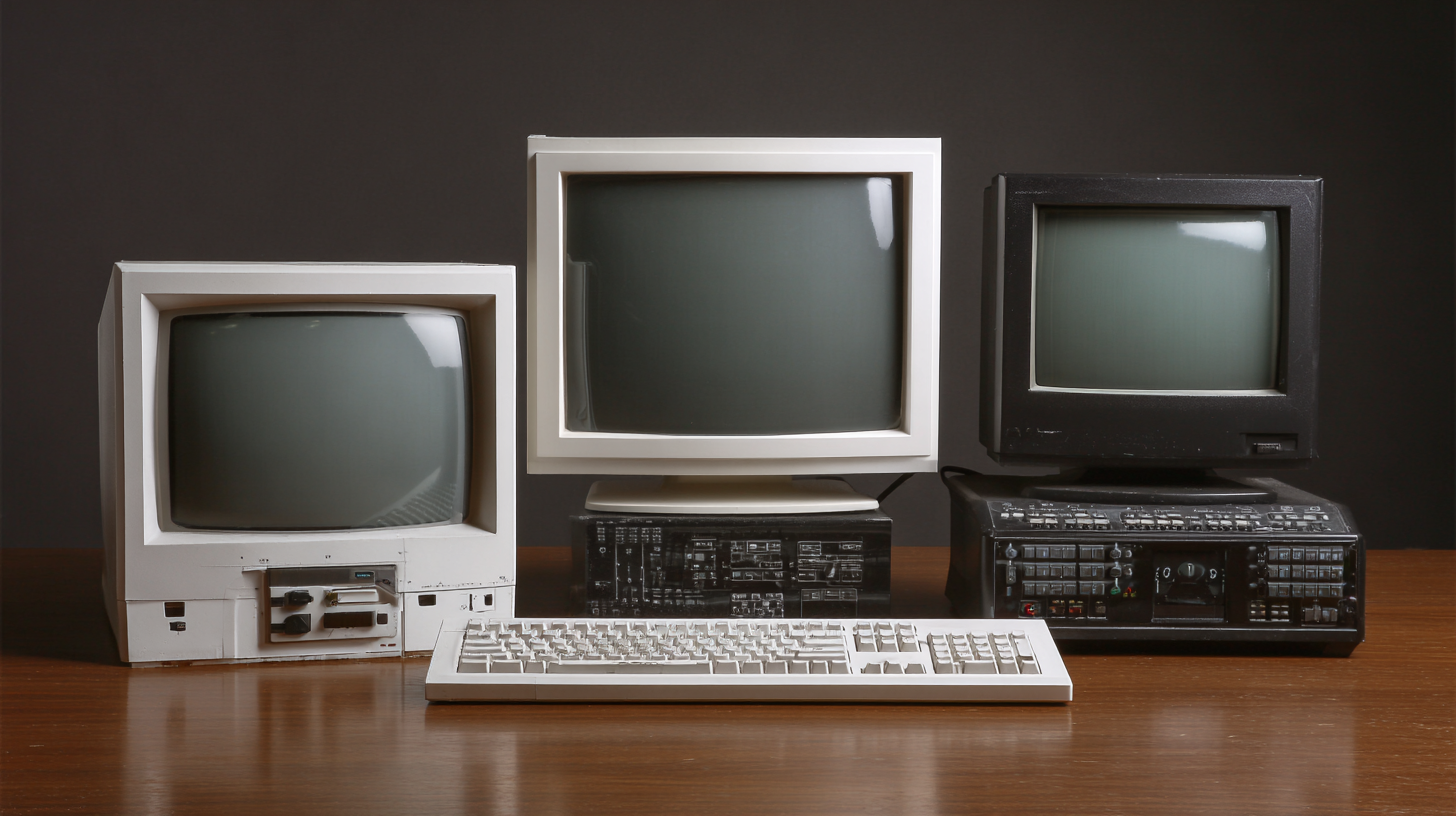Understanding the Evolution of LCD Monitors: From Early Days to Modern Innovations
The journey of LCD monitors has been one of remarkable transformation, evolving significantly from their humble beginnings to their current status as essential tools in everyday technology. Initially developed to replace bulky cathode ray tube (CRT) displays, LCD monitors offered a sleeker, more efficient alternative that consumed less power and provided clearer images. This evolution has not only revolutionized how we interact with computers and multimedia devices but has also set the stage for various modern innovations.

As technological advancements have propelled the development of LCD technology, we have witnessed a range of improvements—from color accuracy and resolution enhancements to the introduction of features like ultra-thin designs and curved screens. This continuous innovation reflects the changing demands of consumers and the growing versatility of LCD monitors in various applications, including gaming, professional work, and home entertainment. By exploring the history and advancements of LCD monitors, we can gain a deeper appreciation for how these displays have shaped our visual experiences and influenced the design of future technologies.
The Birth of LCD Technology: Early Innovations and Challenges
The birth of LCD technology marked a pivotal point in the evolution of display devices, transitioning from bulky CRT monitors to sleek and efficient screens. The first liquid crystal displays date back to the 1970s when researchers at companies like RCA and Sharp experimented with various compounds and configurations. Despite early enthusiasm, these pioneers faced significant challenges, including sluggish response times and limited viewing angles. According to a 2020 report by ResearchAndMarkets, the global LCD market was valued at approximately $117 billion, underscoring the technology's slow yet steady rise to prominence in the decades following its inception.

As manufacturers overcame initial technical hurdles, breakthroughs in thin-film transistor (TFT) technology during the late 1980s and early 1990s propelled LCDs into mainstream use. TFT-LCDs enabled faster pixel response times and improved image quality, leading to widespread adoption in both consumer and professional markets. A report by Statista highlighted a significant uptick in LCD monitor shipments, reaching around 155 million units in 2021. This surge not only signified the success of LCD technology but also set the stage for continual innovations, including enhancements in energy efficiency and color accuracy, further solidifying LCDs as a cornerstone of modern display technology.
Milestones in LCD Development: Key Breakthroughs Over the Decades
The evolution of LCD monitors has been marked by several key breakthroughs that have significantly shaped the technology over the decades. Initially, the development of liquid crystal displays began in the 1960s, with the creation of the first LCD being a simple monochrome screen. This was a pivotal moment, igniting further research and experimentation in flat-panel technology. The introduction of color LCDs in the 1980s transformed the market by enabling richer visuals, leading to their adoption in portable devices like laptops and handheld consoles.
As technology progressed, the 2000s saw the emergence of thin-film transistor (TFT) LCDs, which offered improved image quality and faster response times. This innovation allowed for greater integration into various electronic devices, making LCDs the standard for computer monitors and televisions. Another milestone was the development of LED backlighting, enhancing brightness and color accuracy while reducing power consumption. These advancements significantly boosted the popularity of LCD displays.
**Tip:** When selecting an LCD monitor, consider factors like resolution, refresh rate, and color accuracy to ensure it meets your specific needs, whether for gaming, professional work, or casual use.
Additionally, keep an eye on emerging technologies like OLED, which could offer even greater picture quality and efficiency in the near future. Staying informed and aware of these innovations can help you make better purchasing decisions.
Evolution of LCD Monitor Technology: Key Milestones
Transitioning from CRT to LCD: Market Dynamics and Consumer Trends
The transition from CRT (Cathode Ray Tube) to LCD (Liquid Crystal Display) monitors marked a significant milestone in the evolution of display technology. According to a report by IHS Markit, shipments of LCD monitors surpassed those of CRT monitors as early as 2004, reflecting a fundamental shift in consumer preferences driven by advancements in display technology and the growing demand for slimmer, more energy-efficient devices. By 2010, LCD monitors accounted for approximately 93% of the global monitor market, highlighting their dominance and the rapid decline of CRT technology, which was largely attributed to its bulkiness and high power consumption.
Consumer trends during this transition also played a pivotal role. The increasing focus on aesthetics and ergonomics led manufacturers to invest heavily in developing thinner and lighter LCD screens. Additionally, as digital content consumption surged, particularly with the rise of high-definition video, the demand for improved image quality became paramount. Research by Statista indicates that the global market for LCD monitors is expected to reach around $24.1 billion by 2026, emphasizing how consumer preferences for high-resolution and energy-efficient displays continue to drive innovation in the industry. The LCD evolution is not just about technological advancement but also about meeting the evolving needs and expectations of consumers worldwide.
Understanding the Evolution of LCD Monitors: From Early Days to Modern Innovations
| Year | Technology | Key Features | Market Share (%) | Consumer Trends |
|---|---|---|---|---|
| 1990 | CRT | Bulkier, lower resolution | 70% | Price-sensitive consumers |
| 2000 | LCD | Thinner, improved color accuracy | 20% | Early adopters, tech enthusiasts |
| 2005 | LCD | Widescreen format, higher refresh rates | 40% | Mainstream adoption |
| 2010 | LED-backlit LCD | Better energy efficiency, thinner design | 60% | Eco-conscious consumers |
| 2020 | 4K UHD LCD | Ultra-high resolution, enhanced color range | 80% | Content creators, high-end users |
Modern Innovations: Advancements in LCD Efficiency and Design
Modern LCD monitors have undergone significant advancements in both efficiency and design, revolutionizing how we interact with technology. One of the most notable innovations is the introduction of LED backlighting, which enhances brightness while consuming less power than traditional CCFL backlighting. This shift not only leads to vibrant color reproduction and deeper blacks but also extends the lifespan of monitors, making them more sustainable for users.
In addition to energy efficiency, contemporary designs prioritize slim profiles and sleek aesthetics, catering to consumer preferences for minimalistic setups. Manufacturers are also focusing on ergonomic features, such as adjustable stands and blue light filters, which enhance user comfort and promote better health during prolonged use. The integration of advanced panel technologies, like In-Plane Switching (IPS) and Nano IPS, offers wider viewing angles and faster response times, making modern LCD monitors ideal for both professional and recreational use.
These innovations highlight the evolution of LCD technology, blending functionality with contemporary design practices that meet the demands of today's users.
Future Directions: The Next Generation of LCD Technology and Applications
The future of LCD technology is poised for exciting advancements, driven by the ongoing demand for enhanced display quality and energy efficiency. One of the key directions is the development of Mini LED and Micro LED technologies. These innovations promise to deliver superior brightness, contrast, and color accuracy by utilizing smaller light sources, allowing for more precise control over local dimming and reducing power consumption. As manufacturers continue to refine these technologies, we can anticipate displays that not only elevate user experience but also contribute to sustainability by consuming less energy over their lifespan.

Another promising avenue lies in flexible and transparent LCD screens. These innovations are set to revolutionize applications across various industries, including automotive, architecture, and wearable technology. By enabling displays that can bend or seamlessly integrate into different surfaces, such advancements will enhance aesthetic versatility and functionality. Furthermore, with the rise of smart technology, the integration of LCD displays into everyday objects is expected to expand, ushering in a new era of interactive and immersive experiences that blend the digital and physical worlds seamlessly.
Related Posts
-

Enhancing Retail Visibility: The Impact of LED Window Displays on Customer Engagement and Sales
-

Unlocking the Potential of Outdoor Monitors for Your Business Transformation
-

The Evolution of Large Touch Screen Monitors Transforming Interactive Experiences in Business and Education
-

The Impact of LED Display Rental on Event Marketing Metrics and Audience Engagement Insights
-

How Touch Screen Monitors are Revolutionizing User Interaction in Modern Technology